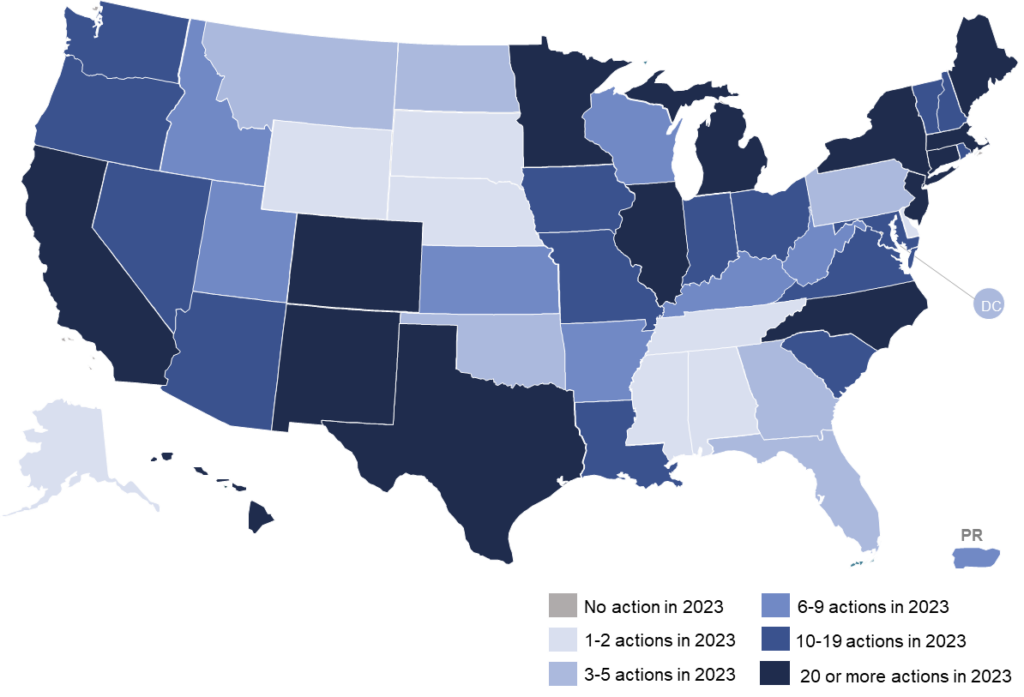The 50 States of Grid Modernization: States Work to Unlock the Potential of Distributed Energy Resources in 2023
Raleigh, NC – (January 31, 2024) The N.C. Clean Energy Technology Center (NCCETC) released its 2023 annual review and Q4 2023 update edition of The 50 States of Grid Modernization. The quarterly series provides insights on state regulatory and legislative discussions and actions on grid modernization, utility business model and rate reforms, energy storage, microgrids, and demand response.
The report finds that all 50 states, plus DC and Puerto Rico, took actions related to grid modernization during 2023 (see figure below), with the greatest number of actions relating to energy storage deployment, utility business model reforms, distribution system planning, energy storage interconnection rules, and performance-based regulation.
2023 State and Utility Action on Grid Modernization

The report highlights ten of the top grid modernization trends of 2023:
- Interest rapidly growing in virtual power plants;
- Addressing cost recovery for interconnection upgrades;
- Examining the impacts of wholesale market participation;
- Studying long-duration energy storage;
- Utilities proposing new performance incentive mechanisms;
- Undertaking grid resilience planning;
- Utilities pursuing innovative pilot programs and projects;
- Utilizing Green Button standards for access to customer energy usage data;
- Providing customers with demand response incentive opportunities; and
- Utilities exploring opt-out time-varying rates.
“In 2023, resilience was top of mind as a plethora of states and utilities considered varying degrees of plans, programs, and investments,” noted Justin Lindemann, Policy Analyst at NCCETC. “Whether it was in pursuit of demonstrating resilient neighborhood models, investigating the potential of long-duration storage applications, or establishing grid resilience rules for utilities to follow in vulnerable areas, the concept of resilience took multiple forms this year as more entities consider its value.”
A total of 774 grid modernization actions were taken during 2023. The report notes that ten of the most active states in 2023 for grid modernization were:
- Connecticut, where regulators adopted a performance-based regulation framework and addressed storage incentives, AMI, data access, interconnection, and many other topics;
- Maine, where lawmakers initiated studies on energy storage, rate design, and the design for a distribution system operator, while utilities filed climate protection plans;
- Michigan, where legislators adopted an energy storage target and initiated a study on long-duration storage, while utilities filed distribution grid plans;
- Massachusetts, where utilities filed draft electric sector modernization plans and performance-based ratemaking proposals, while a long-duration energy storage study was released;
- California, where regulators approved demand response programs and created a new data working group, while the California Energy Commission approved a virtual power plant incentive program;
- Illinois, where utilities filed their integrated grid plans, lawmakers initiated an energy storage study, and regulators considered data access and wholesale market participation;
- Hawaii, where regulators approved final advanced rate, smart DER tariff, and bring your own device designs, while HECO filed its integrated grid plan report;
- Colorado, where regulators opened a proceeding on virtual power plants, Xcel Energy proposed new demand response and storage programs, and Black Hills filed a distribution system plan;
- Texas, where regulators considered a variety of market reforms to improve reliability and resilience, as well as rules for storage and distributed energy resources; and
- North Carolina, where the Commission approved a new residential solar-plus-storage incentive, performance incentive mechanisms, and distribution grid investments for Duke Energy.
“Utilities in several states are exploring or moving ahead with plans to transition customers to time-varying rates on an opt-out, rather than opt-out, basis,” observed David Sarkisian, Principal Policy Analyst at NCCETC. “For example, utilities in Missouri are implementing default time-varying rates, although the price differences between time periods will not be as large as initially proposed.”
In Q4 2023, 48 states, plus DC and Puerto Rico, took some type of action on distributed solar policy or rate design. A total of 467 actions were tracked in Q4.
View the 50 States of Grid Modernization 2023 Annual Review & Q4 Quarterly Report Executive Summary
View and Purchase the 50 States of Grid Modernization 2023 Annual Review Q4 Quarterly Report
View other 50 States Reports – Solar, Grid Modernization, Electric Vehicles and Decarbonization
ABOUT THE N.C. CLEAN ENERGY TECHNOLOGY CENTER
The N.C. Clean Energy Technology Center, as part of the College of Engineering at North Carolina State University, advances a sustainable energy economy by educating, demonstrating and providing support for clean energy technologies, practices and policies. It serves as a resource for innovative, sustainable energy technologies through technology demonstration, technical assistance, outreach and training. For more information about the Center, visit: http://www.nccleantech.
Media Contact: Shannon Helm, shannon_helm@ncsu.edu